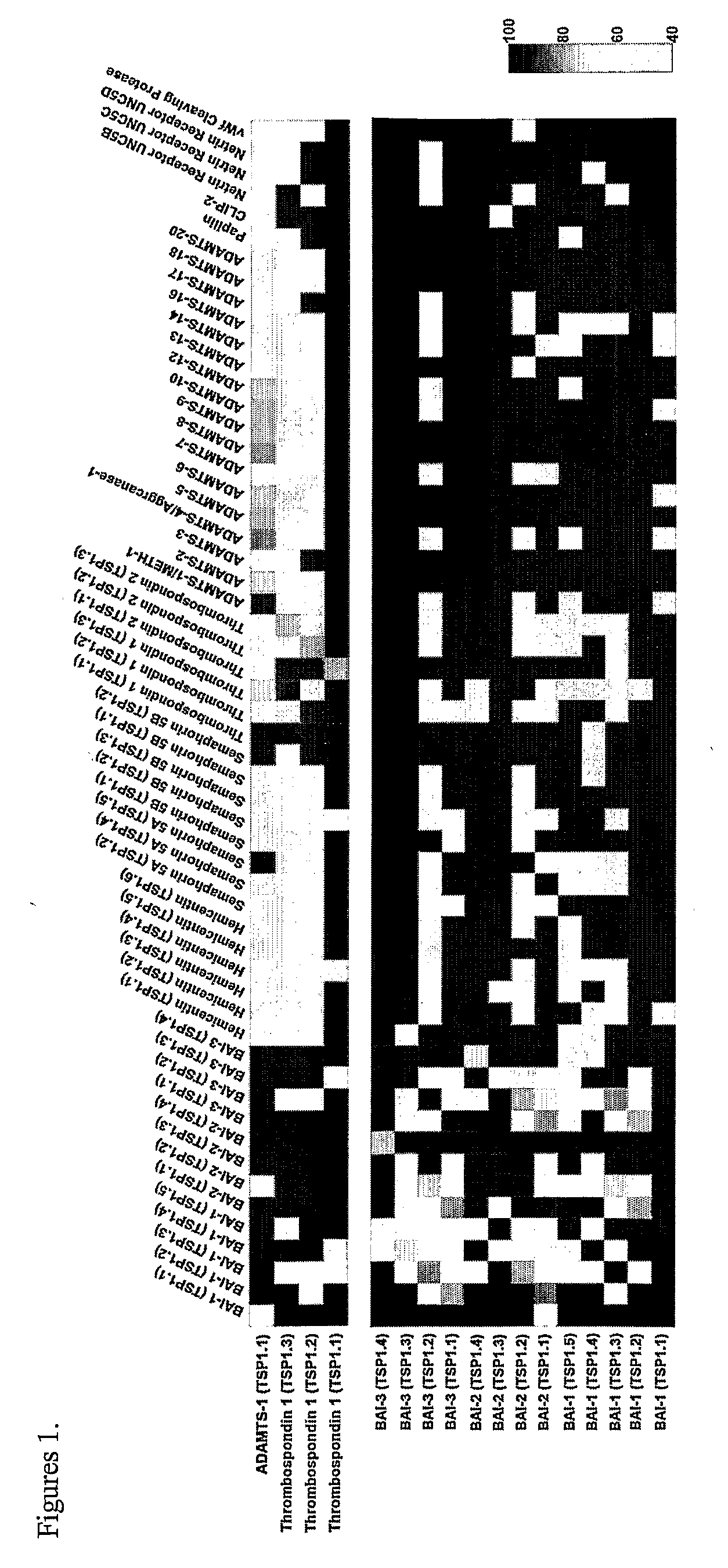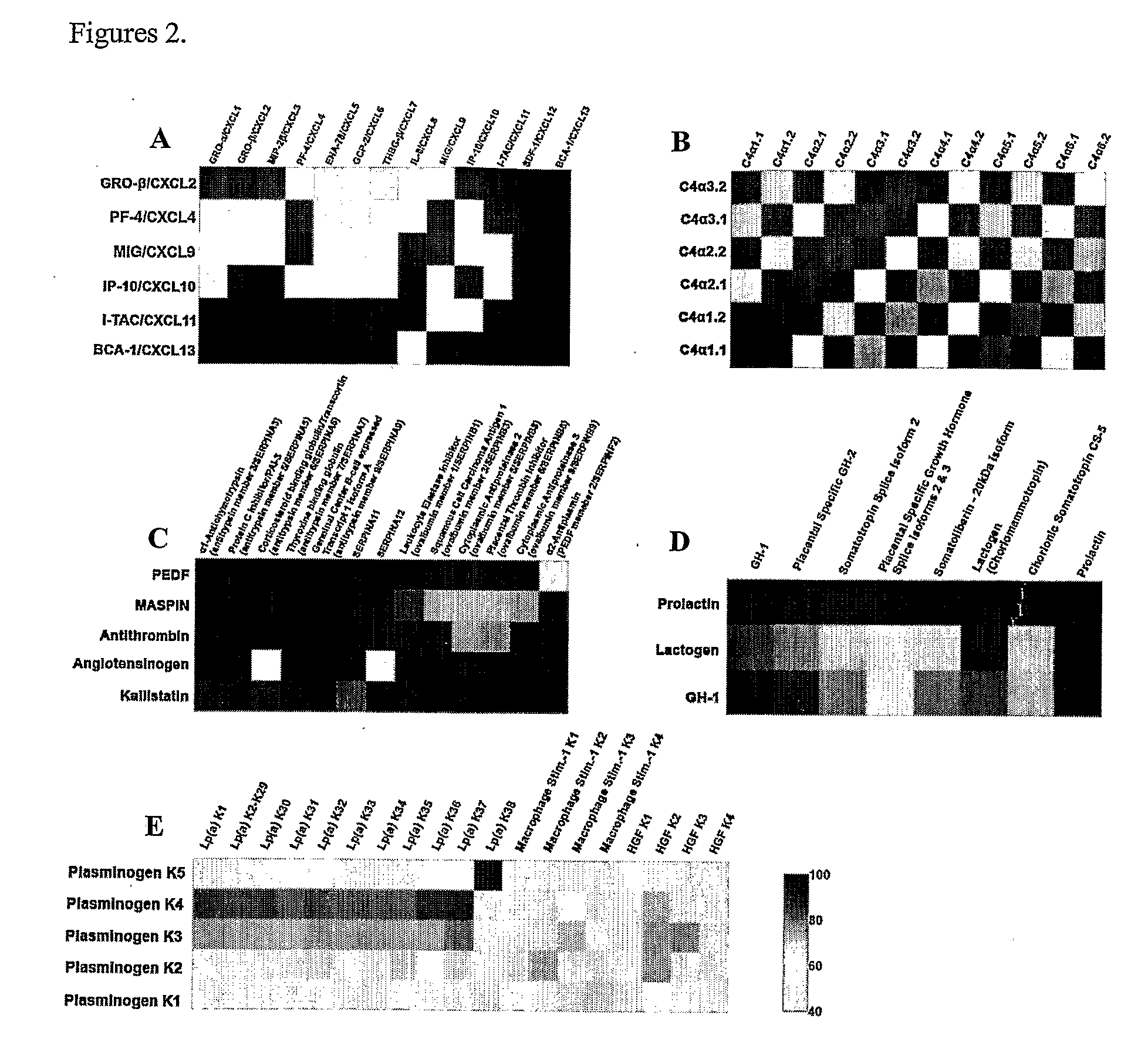Compositions Having Antiangiogenic Activity and Uses Thereof
a technology of compound and antiangiogenic activity, which is applied in the field of compound with antiangiogenic activity, can solve the problems of time-consuming empirical research and the inability to experimentally identify such agents, and achieve the effect of reducing the probability of developing a disorder
- Summary
- Abstract
- Description
- Claims
- Application Information
AI Technical Summary
Benefits of technology
Problems solved by technology
Method used
Image
Examples
example 1
Bioinformatics Approach to Identifying Angiogenesis Inhibitors
[0349]During the last two decades, a large number of endogenous regulators have been identified that either stimulate or inhibit the process of angiogenesis. Disturbance of the fine regulation of these stimulating and inhibiting elements leads to pathologic conditions. One of the hallmarks of cancer progression is the shift of these regulatory elements towards the pro-angiogenic components, often referred to as the angiogenic switch (Folkman, Semin Oncol, 29:15-8, 2002).
[0350]The angiogenesis-promoting regulatory elements include various growth factors. Growth factor signaling promotes the expression of extracellular matrix (ECM)-processing enzymes such as the freely diffusing and membrane-bound matrix metalloproteinases (MMPs), plasmin, and various serine, cysteine and aspartic acid proteinases (cathepsins). While the importance of these enzymes, particularly the cell-secreted proteases, in processing the extracellular m...
example 2
Results of Proliferation Experiments
[0417]As described above, computational bioinformatic algorithms were used to identify a set of protein fragments of naturally occurring, endogenous proteins that may possess potent anti-angiogenic properties. The algorithms identified approximately 200 similarity hits for the proteins or protein fragments with known anti-angiogenic activity. Of the 200 hits, some of which are duplicated, over 150 represent distinct novel putative anti-angiogenic protein fragments. Among the novel fragments, there were hits similar to platelet factor-4, with 7 identified similar protein domains; various fragments of thrombospondin 1, each of which having 45 identified similar fragments; and various tumstatins, with approximately 5 similar fragments each. The proteins with identified similarities and lengths of 100-150 amino acids included the angiostatin kringles; the CXC chemokines Gro-β, IP-10, and MIG, each with approximately 8 top similar protein sites; growth...
example 3
Results of In-Vivo Screening
[0510]A directed in vivo anti-angiogenesis assay (DIVAA) was used to test the anti-angiogenic efficacy of the alpha 5 fibril of collagen type 4, which had the sequence: SAPFIECHGRGTCNYYANS. This peptide showed anti-angiogenesis activity that increased as its concentration increased in in vitro assays. This peptide showed only intermediate activity in in vitro screening assays. The peptide was solubilized in buffer solution at 200 μg / ml without an organic solvent. DIVAA is a reproducible and quantitative in-vivo method of assaying angiogenesis. It involves preparation of silicon cylinders of 20 μl volume, closed on one side, filled with some type of extracellular matrix (for example Matrigel or BME-basement membrane extract) with or without premixed angiogenic factors. These angioreactors are then implanted subcutaneously in the dorsal flank of mice. Accompanied with the onset of angiogenesis, vascular endothelial cells migrate into the extracellular matri...
PUM
| Property | Measurement | Unit |
|---|---|---|
| Fraction | aaaaa | aaaaa |
| Fraction | aaaaa | aaaaa |
| Current | aaaaa | aaaaa |
Abstract
Description
Claims
Application Information
 Login to View More
Login to View More - R&D
- Intellectual Property
- Life Sciences
- Materials
- Tech Scout
- Unparalleled Data Quality
- Higher Quality Content
- 60% Fewer Hallucinations
Browse by: Latest US Patents, China's latest patents, Technical Efficacy Thesaurus, Application Domain, Technology Topic, Popular Technical Reports.
© 2025 PatSnap. All rights reserved.Legal|Privacy policy|Modern Slavery Act Transparency Statement|Sitemap|About US| Contact US: help@patsnap.com



